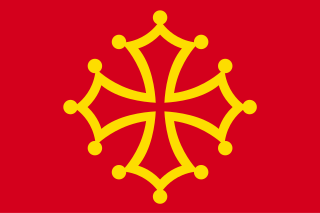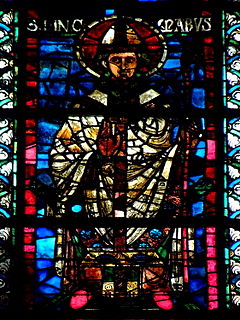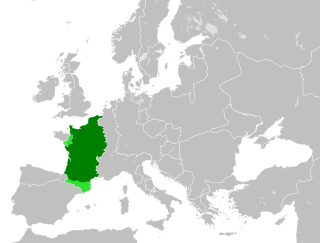
Charles the Bald, also known as Charles II, was a 9th-century king of West Francia (843–877), king of Italy (875–877) and emperor of the Carolingian Empire (875–877). After a series of civil wars during the reign of his father, Louis the Pious, Charles succeeded, by the Treaty of Verdun (843), in acquiring the western third of the empire. He was a grandson of Charlemagne and the youngest son of Louis the Pious by his second wife, Judith.

The County of Toulouse was a territory in southern France consisting of the city of Toulouse and its environs, ruled by the Count of Toulouse from the late 9th century until the late 13th century.

Septimania is a historical region in modern-day Southern France. It referred to the western part of the Roman province of Gallia Narbonensis that passed to the control of the Visigoths in 462, when Septimania was ceded to their king, Theodoric II. The region was also variously known as Gallia, Arbuna or Narbonensis. Septimania territory roughly corresponds with the modern French former administrative region of Languedoc-Roussillon that merged into the new administrative region of Occitanie. Septimania was conquered by the Muslims in the 8th century, when it was known as Arbuna and was made part of Al-Andalus. It passed briefly to the Emirate of Córdoba, which had been expanding from the south during the eighth century, before its subsequent conquest by the Franks, who by the end of the ninth century termed it Gothia or the Gothic March.
The history of Toulouse, in Midi-Pyrénées, southern France, traces back to ancient times. After Roman rule, the city was ruled by the Visigoths and Merovingian and Carolingian Franks. Capital of the County of Toulouse during the Middle Ages, today it is the capital of the Midi-Pyrénées region.

Hincmar, archbishop of Reims, was a Frankish jurist and theologian, as well as the friend, advisor and propagandist of Charles the Bald. He belonged to a noble family of northern Francia.

Hunald I, also spelled Hunold, Hunoald, Hunuald or Chunoald, was the Duke of Aquitaine from 735 until 745. Although nominally he was an officer of the Merovingian kings of Francia, in practice Aquitaine was completely autonomous when he inherited it. His rule corresponds to the lowest point of the Merovingian monarchy, when the kingdom was in fact ruled by the mayors of the palace. Hunald was forced at the outset of his reign to accept the authority of the mayor of the palace Charles Martel, but he tried three times to throw it off in open revolt. He was unsuccessful, although he did manage to retain Aquitaine undiminished. In 745, he retired to a monastery, giving power to his son Waiofar. He later went to Rome, where he died during an attack on the city.
Bernard II was the count of Barcelona, Girona and margrave of Gothia and Septimania from 865 to 878.
Charles the Child was the King of Aquitaine from October 855 until his death in 866.

In medieval history, West Francia or the Kingdom of the West Franks refers to the western part of the Frankish Empire established by Charlemagne. It represents the earliest stage of the Kingdom of France, lasting from about 840 until 987. West Francia emerged from the partition of the Carolingian Empire in 843 under the Treaty of Verdun following the death of Charlemagne's son, Louis the Pious.
Waiofar, also spelled Waifar, Waifer or Waiffre, was the last independent Duke of Aquitaine from 745 to 768. He peacefully succeeded his father, Hunald I, after the latter entered a monastery. He also inherited the conflict with the rising Carolingian family and its leader, Pepin the Short, who was king of the Franks after 751 and thus Waiofar's nominal suzerain.
Bernard II was the count of Poitou from 840 until his death. His ancestry is uncertain. He was most likely the son of Bernard I, on the basis of onomastics. He was probably a member of the Guilhemid family. His brothers were Turpio and Emenon, counts of Angoulême and Périgord, respectively.
Frothar or Frotar was an Aquitanian prelate in West Francia, who held two different bishoprics and three abbacies during a long career. He was appointed Archbishop of Bordeaux around 859, but Viking raids forced him to abandon his seat in 870. With papal approval, he was transferred to the archdiocese of Bourges in 876. He died after 893.

Beaulieu-sur-Dordogne is a commune in the Corrèze department in the Nouvelle-Aquitaine region, central France. Beaulieu is a medieval city, originally dominated by its great abbey of St Pierre, of which only the abbey church remains. On 1 January 2019, the former commune Brivezac was merged into Beaulieu-sur-Dordogne.
Ebroin was bishop of Poitiers from 839 to his death. He took on the administration of the county of Poitiers during a troubled period and continued to faithfully support King Charles the Bald.
Wulfad was the archbishop of Bourges from 866 until his death. Prior to that, he was the abbot of Montier-en-Der and Soissons. He also served as a tutor to Carloman, a younger son of King Charles the Bald. Carloman succeeded Wulfad as abbot of Soissons in 860.
Wenilo was the archbishop of Sens from 836 or 837. Prior to becoming bishop, Wenilo was a palatine chaplain. As bishop, he was one of the leading men in Aquitaine and crowned Charles the Bald king in 848, definitively uniting Aquitaine with West Francia. In 858, he supported the East Frankish invasion and was denounced as a traitor by the king. He reconciled the next year, and retained his office until his death. Nevertheless, Wenilo passed into legend as Ganelon, the archvillain of the Matter of France, his name a byword for "traitor".
Stodilo was the bishop of Limoges from the early 840s until his death. His unusual name may be a corruption of the Latin stolidus, a humble reference to Christian "foolishness" in the eyes of unbelievers.
Ragenar was the bishop of Amiens from 830 to 833 and again from 834 until his death in 849. His predecessor, Jesse, was initially deposed by the Emperor Louis the Pious in 830 for conspiring with his rebellious son Lothair. In 833 he was restored when Lothair forced his father to make public obeisance at an assembly in Soissons. When Louis regained his position in 834, Jesse was again deposed and this time exiled to Italy, where he died in 836.
Viking incursions into Gascony began with a first raid in 840 and ended in 982 with the battle of Taller.
A Jewish Princedom in Feudal France, 768–900 is a book about Frankish medieval history by Arthur J. Zuckerman.







